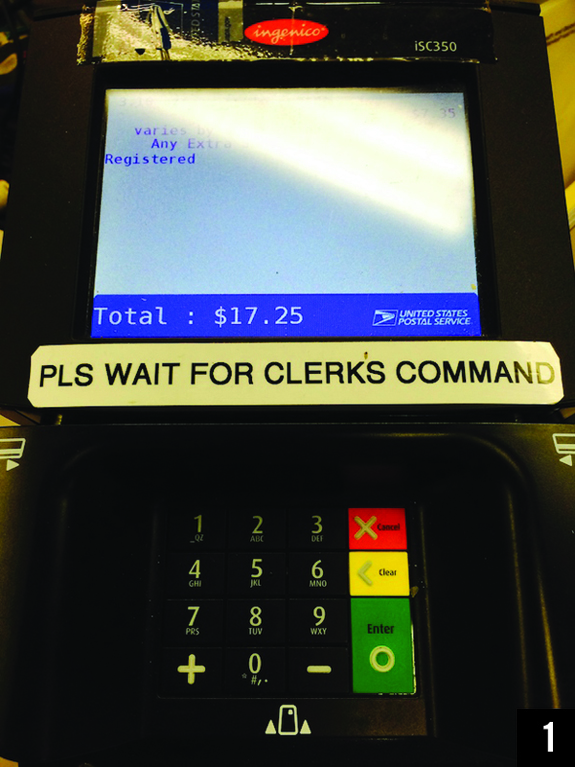Beyond "Designwashing" | The User Experience
 Finding examples of bad user experience (UX) is like shooting fish in a barrel. And while there can be value in pointing out flawed designs—“Hey, look at this example, and don’t do this!”—posting examples of good UX might be more valuable. Regardless, I was so struck with what I saw at the post office recently that I feel compelled to write about it.
Finding examples of bad user experience (UX) is like shooting fish in a barrel. And while there can be value in pointing out flawed designs—“Hey, look at this example, and don’t do this!”—posting examples of good UX might be more valuable. Regardless, I was so struck with what I saw at the post office recently that I feel compelled to write about it.
The instructions taped to this credit card machine ask customers to “PLS WAIT FOR CLERKS COMMAND” (see image 1). This insensitivity to language and punctuation is so severe it’s nearly laughable. It also cuts a bit close to home; pay any attention to signs or instructions slapped up in libraries, and you’ll find similar transgressions.
After spending a bit of time mailing things this past holiday season, I realized that librarians can learn an even greater lesson from the post office. I’m not ashamed to say that I find the U.S. Postal Service’s (USPS) services impenetrable. While I understand that I can bring a letter or package there, present some money for postage, and the item will most likely end up where I want it to go, I don’t have a very solid understanding of the nuances.
For example, here are a few delivery options now available from the USPS: Priority, Priority Mail Express, Standard Post, First-Class, Priority Flat Rate, Prepaid Forever Priority Mail Flat Rate, Tracking, Insurance, Critical Mail, Business, Parcel, Package, Media Mail, Global Express Guaranteed, and Priority Mail Express International.

Does it have to be this complicated? Doubtful. All of this jargon is rather devoid of intuitive meaning, and it has a disempowering effect. Instead of enabling me to send something in the way that best suits my needs, the quixotic service design introduces friction and causes me to struggle.
Clarity and support
I’m sure you know where I’m going with this. With just a bit of self-awareness we should realize that libraries often do the same thing. Things like using jargon, siloed service desks, clunky websites, and unsupportive facilities all burden members with cognitive overload. The options at the post office make sense to its employees because they’re exposed to it every day. The design of our services makes sense to us because we established them. But outsiders don’t always have the knowledge that develops with repeated exposure.
This problem requires a deep solution. A simple “designwashing” won’t help. Take, for instance, the redesigned visual identity launched last summer for the USPS flat-rate options (see image 2).
Looks fresh and modern, right? It certainly is a step in the right direction, but it is a bit shallow. The visual design is only one touchpoint among many, and if the design of the package isn’t backed up by services that are equally as nice, the overall UX won’t be outstanding.

Libraries need to do more
Libraries haven’t done a tremendous amount of “designwashing” to improve people’s experience and perception, but they do often take a somewhat shortsighted approach: customer service training. Let me be clear; libraries should strive to have outstanding customer service. The human interactions in our buildings are a vital touch point. But a customer service training workshop every few years will not help solve the larger problem of service design that is not user centered.
In addition to improving the visual design in our libraries while also improving customer service, we must take a deeper look at the programs and services we offer to ensure they’re aligned with what our communities want and need. This type of examination requires the use of techniques that help cut through our institutional knowledge and biases. Contextual inquiries, user interviews, persona development, storyboarding, use case creation, and participatory design are just a few of the valuable techniques we can employ.
The tools are there, we just need to shift our priorities and work with them. When we do, we’ll learn more about the people we serve and how we can change our services so that instead of struggling when using the library, they’ll be empowered to accomplish their goals. In the next installment of “The User Experience,” I’ll highlight some libraries that have done just that!
ALREADY A SUBSCRIBER? LOG IN
We are currently offering this content for free. Sign up now to activate your personal profile, where you can save articles for future viewing









Add Comment :-
Comment Policy:
Comment should not be empty !!!
Anthony Ballas
In my own experience at Denver Public Library, via interacting with patrons and working on a service delivery committee on this very same problem, I have noticed many of the same transgressions embedded in the texture of the library itself- the overall design, the signage, accessibility etc. Our goal on the service delivery committee was to try and develop marketing strategies that would appeal to specific customer segments, much like a advertising firm that focuses on the marketability of customer groups for a business. This approach, I claim, was totally wrong. To frame the problem of library (in)accessibility into the context of customer service in business, is to miss a crucial point; that the rampant marketing in business provides the problem of (in)accessibility to the library. To put it simply, rampant advertising for the purposes of economic gain that condition the subject as consumer contributes to the reduced popularity of the library, creating the necessity for libraries to "compete" on what seems like a similar plane of advertisement. The problem here, is the reduction of the library patron to a mere number of represented customer demographics, just like a business that focuses on things like race, gender, economic status, household value, etc. It is as though the library is expected to function similarly to a business, which of course, sets up the library for failure given its popularity in contemporary society. Why compete in the very problem that creates the conditions to compete in the first place (like the vulgar phrase, "if you cannot beat them, join them," which in this case should be changed to, "since the entity that creates the conditions to compete in the first place cannot be beaten, it is better to reproduce the problem itself simply to show we [the library] have some kind of fight left despite our failing popularity")? Why is this even important? Although what the author noticed in the post office was very different than even the flawed messages and systems in the library, I think that both institutions function within the same sphere of expectations from the user. There is a tri-leveled system that governs these two spaces, that plays on the expectations of the user: there is the explicit written laws such as rules and regulations that apply to the structure of the institution like "no guns allowed," and "no shirt no shoes no service." This layer makes the policy explicit to the user, and thus there is no confusion as to the limit of the what the law says. Second, there is the implicit, or assumed law, such as norms of behavior that the user understands in order to maintain a civil atmosphere, like the understanding that the users are able to receive service in the order in which they arrived, and that "cutting" line is not acceptable, or in the case of the library, that the user is to maintain a quiet demeanor, almost silent while in the library, and that loud outbursts are frowned upon. In this level, the unwritten, but widely understood and enforced norms allow a smooth functioning within the guidelines of the institutions itself. The last level is a bit more complicated, it is what Slavoj Zizek calls the "obscene underside of the law," in which the very understanding of the flaw in the system itself provides its smooth functioning. In the case of the post office, the author claims that despite the confusing language and perhaps unnecessary choices etc., he understands that his package probably will still make it to its desired destination. This level is crucial to the way in which the institution maintains itself. It this level is transgressed, or missed, or something, then the smooth functioning of the institution is lost, and suddenly the user that questions the assumptions requires a direct addressing of what is otherwise simply assumed. We see this in the way that the popular shows "Curb Your Enthusiasm" and "Seinfeld" function: a normalized, assumed, quotidian, practice that ensures smooth functioning is examined and thus the entire framework of what the practice supports crumbles. Larry David's character in his popular show does just this. A normalized assumption within a relationship, like Larry David keeping his mouth shut about something embarrassing, is directly transgressed by David, and the entire logic of the assumption becomes brutally placed into question. I agree that simple annual training programs do not work. However, I think the author falls short of his own observation of his confusion but ultimately, his acceptance of the function of the post office. It is his very confusion qua acceptance that allows the post office to keep functioning in the way that it does; as an irritating and inefficient service that is nonetheless trusted. Same as the library, it is the very gaps in understanding (the confusion of directions, self check machines, inaccessibility etc.) that allow it to function in the way that it does; as a inefficient, irritating service that is nonetheless trusted to preform its function for the user. What we perhaps need is not just a simple reconstruction of the design, systems, signage, or whatever else as the author suggests, but rather a critical self critique into the very acceptance of the library itself. It is not the visual rhetoric, the services offered, or the programs, that simply create the problems for the user, or the decreasing popularity of the library. Instead, it is the libraries attempt to fix these very "problems," that furthers the problems of unpopularity, confusion, etc. It is like, instead of actually fixing something, the problems are just hidden behind, or swept "under the rug" of the visual rhetoric, signage, appeal, and, in the case of my own branch in Denver, Modern style architecture. The overall function of the library does not exist in its advertising components, or strictly in its accessibility, but rather in the system that it attempts to somehow maintain in competition with the rising popularity of economic-business advertising. Library patrons are not customers, but somehow the language has shifted recently, just as it has shifted in the university sector. We are at this point engaged in a battle to assimilate into popular ideology, instead of becoming a refuge away from it.Posted : Mar 27, 2014 01:25